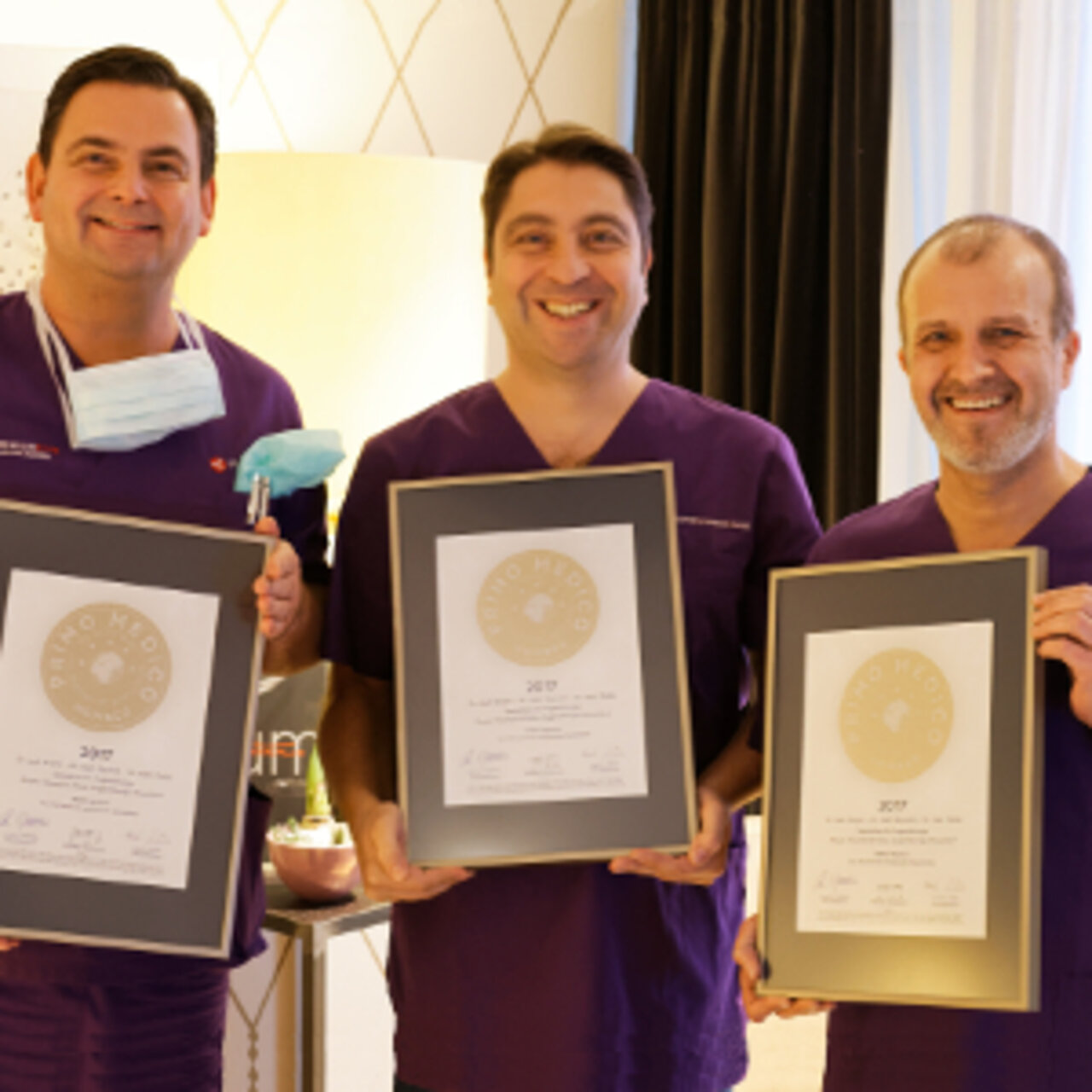Specialists in Canaloplasty
4 Specialists found
Information About the Field of Canaloplasty
What Is Canaloplasty?
Canaloplasty is a relatively new surgical procedure for glaucoma treatment.
Glaucoma is usually caused by excessive intraocular pressure. Elevated intraocular pressure occurs when the outflow of the eye's aqueous humor is obstructed, and the fluid backs up in the eye. Usually, the aqueous humor drains through the Schlemm's canal at the angle of the eye's anterior chamber. In glaucoma, this canal is often collapsed.
The Schlemm's canal is widened with a microcatheter during canaloplasty, and a suture is inserted into the canal. Canaloplasty restores natural aqueous humor outflow and is intended to keep the canal permanently open.
Canaloplasty was developed as an alternative surgical method to trabeculectomy, which is often associated with complications.
Compared to trabeculectomy, canaloplasty is characterized by fewer complications, a rapid healing process, shorter hospital stays, and fewer follow-up visits. However, intraocular pressure can be lowered more effectively with trabeculectomy.
Who Is Eligible for Canaloplasty?
In principle, canaloplasty is suitable for all types of open-angle glaucoma. However, open-angle glaucoma or wide-angle glaucoma is the most common type of glaucoma, accounting for more than 90 percent of cases.
Since canaloplasty can only achieve a moderate reduction in pressure, the method is primarily considered for patients with mild to moderate glaucoma.
This gentle surgical method is particularly suitable for patients with a high risk of complications, chronic conjunctivitis, or older patients.
Canaloplasty is not suitable for people with narrow-angle glaucoma, in which there is narrowing or occlusion of the chamber angle and chronic angle-closure glaucoma. The surgical method is also not valuable for neovascular glaucoma, in which vessels close the chamber angle, in complicated glaucoma with scarring or congenital glaucoma.
What Is the Procedure?
Canaloplasty can be performed with local anesthesia without general anesthesia. During the procedure, the surgeon opens the white sclera of the eye at a small spot at the junction with the clear cornea. This is where the Schlemm's canal is located, which runs in the sclera all around the clear cornea. Next, the surgeon inserts a tiny catheter through the Schlemm's canal. As the catheter is withdrawn, a thread is placed in the canal, and a viscous substance called viscoelastic is inserted to stretch the canal. This is to keep the canal permanently open and restore drainage. Finally, the surgeon covers the canal and sutures the sclera tightly.
The procedure is followed by an inpatient stay of a few days and a follow-up visit after approximately four to six weeks.
What Is the Experience?
More severe complications rarely occur with canaloplasty. The healing process is fast, and the inpatient stay is shorter than with trabeculectomy. In addition, fewer follow-up visits become necessary.
However, trabeculectomy is more effective at lowering intraocular pressure. Canaloplasty can lower intraocular pressure to about 15 to 16mmHg. Studies showed that about 30 percent of patients achieve the target pressure established before surgery through canaloplasty and subsequently manage without eye drops. Another 40 percent require additional eye drops to lower the pressure to the desired level. Despite surgery and eye drops, more than one-third do not achieve the target pressure.
With trabeculectomy, the target pressure is reached in about 70 percent of patients without additional eye drops. However, nearly one-third of patients do not achieve the desired pressure reduction with surgery and eye drops even here.
In canaloplasty, the potential pressure reduction also depends on the baseline value. This means that pressure is unlikely to be reduced sufficiently in advanced glaucoma with high intraocular pressure.
However, it has been found that more significant pressure reduction is possible with canaloplasty in combination with cataract surgery, in which the pressure can be lowered to 13 to 14mmHg. In addition, during cataract surgery, the lens is removed, deepening the anterior chamber of the eye. This seems to increase the effect of canaloplasty. Therefore, canaloplasty is a good treatment option for glaucoma and cataracts.
Are There Alternatives to Canaloplasty?
An alternative to canaloplasty is trabeculectomy. In this surgery, which has been carried out for decades, an artificial drain is created for the aqueous humor. The aqueous humor is directed under the conjunctiva of the sclera.
Trabeculectomy is the most effective way to lower intraocular pressure to 12 to 13mmHg. Therefore, trabeculectomy is recommended for advanced glaucoma with high intraocular pressure. However, the surgery is often associated with complications and costly follow-up.
There are several other surgical methods, for example, laser trabeculoplasty. This gentle method does not permanently lower intraocular pressure but is a temporary solution in some instances.
For some complicated glaucomas, such as congenital glaucoma or glaucoma with severe scarring, neither canaloplasty nor trabeculectomy is suitable. Implant surgery, for example, is suitable in these cases.
What Are the Risks of Canaloplasty?
It is infrequent for more severe complications to occur during canaloplasty.
However, small hemorrhages into the interior of the eye often occur. However, these usually disappear by themselves within the first few days after the surgery.
Another relatively rare complication is the detachment of the posterior limiting lamina. The posterior limiting lamina is a layer of the cornea. When the viscoelastic is inserted, it can partially detach from the overlying corneal layer, the corneal stroma. Sometimes there is also bleeding into the cornea, but treatment is not necessary either. The cornea heals by itself.
Occasionally, the microcatheter is pushed incorrectly, or it is not possible to forward it entirely through the Schlemm's canal. Rarely, it happens that the suture slips out of the canal into the anterior chamber of the eye.
However, in some patients, a second operation is necessary if the pressure could not be lowered sufficiently with the canaloplasty. In this second surgery, YAG-laser- goniopuncture, a structure of the ventricular angle, the trabecular/descending lamella, is cut with a laser. This improves the outflow of aqueous humor into Schlemm's canal.
Which Clinics Are Specialized?
It is best to go to an eye clinic that specializes in glaucoma surgery for canaloplasty. You will find experienced surgeons there who perform the surgery regularly.
Every patient who needs a doctor wants the best medical care. Therefore, the patient is wondering where to find the best clinic. As this question cannot be answered objectively and a reliable doctor would never claim to be the best one, we can only rely on the doctor's experience.
We will help you find an expert for your condition. All listed doctors and clinics have been checked by us for their outstanding specialization in the field of canaloplasty and are waiting for your inquiry or treatment request.
Sources:
- Klink T. et al. (2012). Nicht penetrierende Glaukomchirurgie. Ophthalmologe 2012; 109:807-817
- Matlach J., Klink T. (2015). Trabekulektomie versus Kanaloplastik. Ophthalmologe 2015; 112:325-331
- Matthei M. et al. (2011). Kanaloplastik. Eine neue Alternative in der nicht penetrierenden Glaukomchirurgie. Ophthalmologe 2011; 108:637-643
- Nassri et al. (2020). Therapieerfolg von Kanaloplastik und Trabekulektomie durch denselben Operateur mit demselben Erfahrungslevel im Langzeitverlauf. Ophthalmologe 2020; 117:1025-1032
- Reznicek L. et al. (2016). Möglichkeiten und Grenzen der operativen Glaukomtherapie. Ophthalmologe 2016; 113:833-837
- Taruttis T. et al. (2018). Verglaich von Trabekulektomie und Kanaloplastik. Drucksenkender effekt und postoperatives Komplkations- und Interventionsspektrum. Ophthalmologe 2018; 115:137-144



